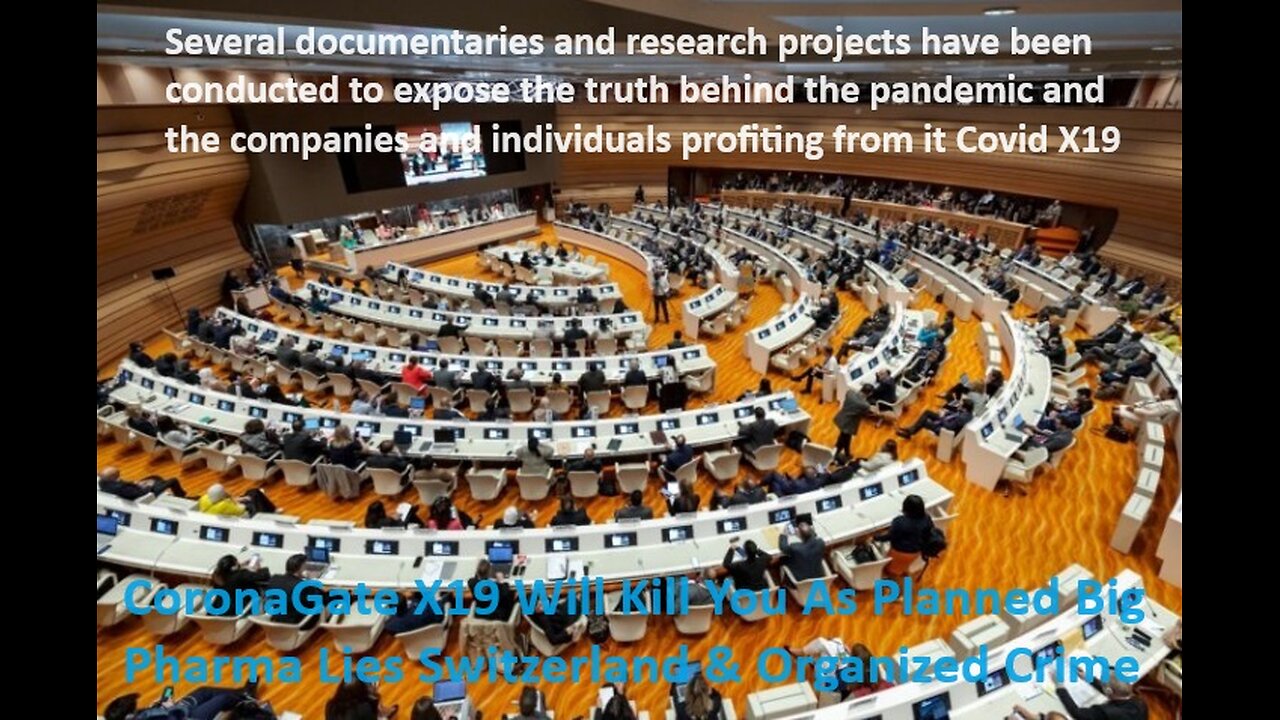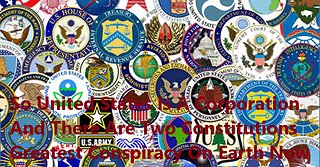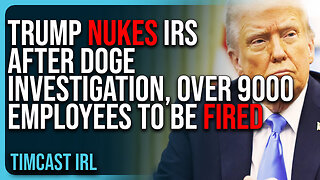Premium Only Content

CoronaGate Will Kill You As Planned Big Pharma Lies Switzerland & Organized Crime
The Real Truth About CoronaGate Big Pharma Will Kill You As Planned By Switzerland And Organized Crime And Big Pharma companies, such as Pfizer, have been accused of profiting from the COVID-19 pandemic. Pfizer has removed itself from the New York Stock Exchange, allegedly due to its money laundering operation being exposed. The World Health Organization defines One Health as “an approach to designing and implementing programmed, policies, legislation and research in which multiple sectors communicate and work together to achieve better public health outcomes”.
Switzerland’s Role
Switzerland has been linked to the global power structure, with many companies and individuals profiting from the pandemic. The country’s banking system and financial institutions have been accused of facilitating money laundering and other illegal activities.
Organized Crime
The pandemic has been described as a global psyop, with organized crime syndicates profiting from the chaos and fear it has created. Italian black nobility families have been mentioned as being involved in the pandemic scam, along with other powerful individuals and families.
Documentaries and Research
Several documentaries and research projects have been conducted to expose the truth behind the pandemic and the companies and individuals profiting from it. Iain Davis has been featured in one such documentary, discussing the complicated web of global power and the role of Switzerland and Italian black nobility families.
Conclusion
The CORONAGATE scandal involves Big Pharma companies, Switzerland, and organized crime syndicates. The pandemic has been used as a means to profit and exert control over individuals and governments. It is essential to continue researching and exposing the truth behind this global crisis.
WHO Pandemic Treaty The Good, The Bad, & The Ugly The ‘Pandemic Agreement’ What it is, What it isn’t, and What it Could Mean for the U.S.A.
Countries are nearing the end of negotiations on a new international ‘pandemic agreement’ (also referred to as a ‘pandemic accord’ or ‘pandemic treaty’). For more than two years, representatives from member states of the World Health Organization (WHO) have held a series of meetings to draft this new agreement, with a vote on the final text expected in May 2024 during this year’s World Health Assembly (WHA). The Biden administration has supported the concept of an agreement, and has been engaged in negotiations since the process launched. At the same time, several issues have been raised by U.S. policymakers and others, including whether and how the U.S. should ultimately choose to become a party to the agreement. A delay in reaching an agreement could bump the negotiations closer to or beyond the U.S. Presidential election in November, which could have significant implications for U.S. participation. If President Trump were to be elected, for example, it is unclear if he would support an agreement, given his criticism of WHO and his move to withdraw from the organization when he was President, as well as his overall “America First” approach to international engagement.
What is the Pandemic Agreement?
The pandemic agreement is a potential international agreement currently being negotiated by the 194 member states of the WHO, including the U.S. Many governments and WHO leadership felt it was necessary to develop a new agreement to address some of the weaknesses in capacities and lack of international cooperation that occurred during the global response to COVID-19. The formal negotiation process (known as the International Negotiating Body, or INB) was launched in 2021. In the view of the WHO Director-General, there would be three key benefits to a new agreement: driving a more equitable global response, helping safeguard national health systems, and enhancing cooperation among member states during pandemics.
According to the latest publicly available draft text (dated 13 March), the overall objective of this new pandemic agreement is to help the world “prevent, prepare for and respond to pandemics.” Among the provisions included (all of which are still being negotiated) are definitions and principles, aspirational goals for improving pandemic preparedness and response capacities, supply chain and logistics, communication, and oversight and implementation for the agreement, with some of the more contested and debated provisions being financing for pandemic preparedness and response, pathogen access and benefit sharing (PABS), intellectual property rights, technology transfer and research and development for pandemic-related products. Also a topic for debate has been the inclusion of the concept of common but differentiated responsibilities (CBDR), meant to address equity concerns by asking richer countries to take on greater obligations to address common goals in pandemic preparedness and response than poorer countries.
What are possible outcomes of the agreement negotiations?
WHO member states are expected to vote on the final text of the agreement during the WHA meeting this year, which starts on May 27, 2024. It is also possible that before then, member states decide to delay the vote to allow for more negotiating time. They may also choose to halt the process temporarily or permanently if sufficient agreement cannot be reached. If member states vote in favor, the agreement would be adopted as one of several different types of international legal agreements allowed under the WHO Constitution. Which form it takes is the subject of ongoing negotiation at the INB, but possibilities include a “treaty”, a “regulation” or a “resolution”/”decision,” each of which has specific characteristics and implications (see Table 1).
Treaty: Proponents of the agreement, and most member states, have supported a “treaty” as the preferred outcome as it is expected to have the greatest influence and broadest potential scope. Indeed, the latest draft of the agreement includes text that indicates adoption and ratification as a treaty (Article 34), but this could change. However, a treaty would have the highest bar to clear in terms of votes needed for approval, subsequent ratification by a minimum number of member states to enter into force, and only would apply to member states that do ratify the treaty.
Regulation: If the agreement is approved as a “regulation,” in contrast, it would enter into force immediately for all member states (unless they opt-out), but this form could be seen as less influential compared to a treaty and could have some limitations on the issues it can directly address.
Resolution or Decision: Finally, WHO member states could choose to approve an agreement as a “resolution” or “decision”, which would essentially be a statement of support for certain principles without specific legal or other obligations for member states and would therefore be seen as the weakest and least ambitious form of agreement.
What has been the U.S. engagement with and positions on the agreement so far?
The Biden Administration has been actively participating in the negotiations since the INB was formed in 2021. Co-led by the State Department and the Department of Health and Human Services, the U.S. representatives’ stated goals include to “enhance the capacity of countries to prevent, prepare for, and respond to pandemic emergencies…ensure all countries share data and laboratory samples from emerging outbreaks quickly, safely, and transparently…[and] support more equitable and timely access to, and delivery of, vaccines, diagnostic tests, and treatments and other mitigation measures” during health emergencies. The U.S. supports the deadline of May 2024 as the goal for voting on an agreement.
With closed-door negotiations still ongoing, information about U.S. positions on different components of the agreement is limited and may be subject to change. Statements from officials indicate U.S. support for the overall principles in the draft agreement, such as the aspirational goals for building pandemic preparedness capacities and calls for international cooperation. U.S. officials also have come out in favor of a some kind of PABS system where countries would commit to share pathogen samples and information, and manufacturers of vaccines, drugs and other pandemic-related products would “set aside a dedicated percentage of production for equitable distribution during pandemics.” In contrast, U.S. representatives have made critical comments about the idea of requiring intellectual property rights on pandemic-related products to be waived on a temporary basis during a pandemic, saying “eliminating intellectual property protections will not effectively improve equitable access during pandemic emergencies, and will in fact harm the systems that have served us well in the past”. While U.S. officials have voiced support for voluntary technology transfer goals in the agreement, they have been critical of including language that requires mandatory technology transfer. At recent INB meetings, U.S. officials have voiced opposition to the common but differentiated responsibilities (CBDR) concept and argued against creating a new pooled funding mechanism for pandemic preparedness and response through the agreement.
What objections are being raised in the U.S. about the agreement, and is there evidence supporting these objections?
Some U.S. policymakers and observers have raised objections to the agreement in part or in full. Below are some of the commonly expressed objections, and available evidence regarding the objections:
Concerns about U.S. sovereignty and/or ceding authority to WHO. Some Republican members of Congress have expressed concerns that an agreement would threaten U.S. sovereignty and could cede power to WHO. However, regardless of which type of instrument is ultimately adopted, an agreement would not change WHO’s power or member state sovereignty. WHO itself is not to be a party to an agreement, but rather its role is to provide a forum for the negotiations held by member states themselves. The current draft (Article 24) makes this point explicitly, saying the agreement “should not be interpreted” as providing WHO with any authority over domestic laws or policy. There is no mechanism included or possible for punishing member states for not meeting the goals of the agreement. Biden administration representatives involved in the negotiations have similarly stated that an agreement would not provide WHO with “…any authority to direct U.S. health policy or national health emergency response actions.” In addition, governments can choose not to be a party, opt out, or register reservations for any agreement. The U.S. government has regularly submitted reservations to other international agreements regarding federalism and its obligations, including to the WHO-based IHR revision approved in 2005.
Concerns about financial burden on U.S. taxpayers and/or U.S. companies. Some Republican lawmakers have expressed concerns than an agreement would require U.S. contributions, placing a financial burden on U.S. taxpayers. In addition, some lawmakers and pharmaceutical industry groups have raised concerns that an agreement would require contributions from U.S. pharmaceutical companies involved in producing pandemic-related products (such as tests, treatments, and vaccines), placing an undue financial burden on those companies. At this time, there is no language in the draft agreement text requiring contributions from member states such as the U.S. However, the text does propose (Article 20) a “Coordinating Financial Mechanism” to support global pandemic preparedness efforts, which would include a “pooled fund” drawing from several sources including voluntary contributions from governments. It also includes language (Article 12) creating a system for pathogen access and benefit sharing (PABS), for which manufacturers of pandemic-related products such as pharmaceutical companies may be expected to pay annual contributions (amounts not specified) to support the PABS system and would be expected to provide WHO (or another mechanism for global sharing) a 10% share of their production of relevant diagnostics, therapeutics, or vaccines at no cost plus an additional share (10%) at reduced prices during pandemics. Current draft language (Article 12) also proposes that manufacturers can make further voluntary, non-monetary contributions “such as capacity-building activities, scientific and research collaborations, non-exclusive licensing agreements, arrangements for transfer of technology and know-how.”
Concerns about intellectual property rights, and implications for U.S. pharmaceutical company innovation and development of pandemic-related products. S. lawmakers from both parties, along with pharmaceutical industry groups, have raised concerns that an agreement could “undermine” intellectual property (IP) rights and pharmaceutical innovation by requiring companies to “give away” IP protections on pandemic-related products they develop, thereby reducing incentives to invest in research and development of such products. At this time, the revised draft text of the agreement does not require companies to give up IP protections. One section (Article 11) recommends countries and companies consider supporting “time-bound waivers of intellectual property rights” in order to speed or scale up manufacturing of pandemic related products but the preamble of the current draft recognizes “protection of intellectual property rights is important for the development of new medical products,” while also recognizing concerns about IP on prices of those products.
Concerns about transparency of U.S. positions on the agreement provisions and its adoption. Civil society groups and others have raised questions about the transparency of U.S. engagement with the agreement negotiations, and the lack of access to draft negotiating texts. While throughout the process an official draft negotiating text has been released on only a few occasions, this is in large part due to the multiple parallel closed-door negotiations that took place earlier focusing on different sections of the agreement, resulting in a lack of an “interpretable” text given the amount of edits being suggested by member states. In addition, policymakers and others have criticized the U.S. negotiators for not being transparent about whether they will seek ratification of the agreement through the U.S. Senate, allowing a role for Congress in its consideration, or seek to approve an agreement solely through Executive Agreement. While Senate ratification followed by Presidential signature is the formal process by which treaties are ratified under the U.S. Constitution, the U.S. President has the option of acceding to a treaty/agreement through executive action alone, without the advice and consent of the Senate.1 In fact, the great majority (estimated at over 90%) of all U.S. international legal agreements are approved via executive action rather than formal Senate approval.
A few other concerns have been raised about the agreement, for which there is little evidence. For example, some Republican members of Congress have raised a concern that the agreement would direct U.S. tax dollars to be used to fund abortion overseas. However, there is no evidence – in statements from participating governments, the WHO, or in the text of the draft itself – indicating funds associated with agreement are meant to or could be used in support of abortion, which in any case is not an activity linked to the pandemic preparedness capacity-building that is the subject of the agreement. Further, U.S. law and current policies have long prohibited U.S. foreign assistance from supporting abortion overseas. Another concern raised by some Republicans and other stakeholders is that China has undue influence at WHO and therefore the validity of any agreement negotiated under WHO is compromised. The origin of the agreement can be traced back as an initiative of primarily European member states rather than China, and China’s role has been that of one of many member states rather than a controlling force shaping negotiations.
Looking Ahead
Much remains to be determined in terms of the specific wording and content of the pandemic agreement, and indeed whether an agreement will be reached at all. Member states are currently engaged in the final rounds of negotiations and much could change between now and a final version of the agreement. In any case, member states expect to conclude these negotiations by the end of May 2024 and if there is consensus by then, the Biden Administration will have to decide whether and how the U.S. would become party to the agreement, including whether any U.S. reservations would be submitted. However, with U.S. elections happening in November 2024 any delay in reaching an agreement could create more uncertainty about U.S. engagement, especially if President Trump were to be elected, given his prior administration’s history of speaking out against WHO and moving to withdraw the U.S. from WHO membership, as well as his more general “America First” approach to international engagement. With Republican lawmakers and associated groups echoing those calls to withdraw U.S. support for WHO, U.S. engagement with any agreement could be very different depending on the electoral results.
Lawrence O. Gostin is “confident” that countries will adopt a pandemic accord at the 2024 World Health Assembly.
The question is whether it will include the kind of “robust norms” necessary to ensure that the new accord is “transformative” with respect to correcting disparities and injustices uncovered in the last pandemic, and effective in its enforcement of new norms.
As the head of Georgetown’s WHO Collaborating Center in national and global health law, Gostin is playing a key behind-the-scenes role in negotiations.
Here is his take on what is at stake and what choices need to be made.
Health Policy Watch: What is a pandemic treaty? What does it entail?
Lawrence Gostin: The Pandemic Accord, currently in development, has the potential to be a landmark in global governance, akin to the Paris Agreement. Its impact will depend on its final content, mainly if it includes strong norms.
These norms should ensure equitable sharing of lifesaving resources, promote a “One Health” approach to prevent zoonotic diseases and establish robust compliance mechanisms. The Accord could transform global health law by emphasizing equity, a holistic health strategy, and effective enforcement.
HP-Watch: Based on your observations of the draft versions of the treaty, where are the opportunities for an “accord”?
Gostin: I’m confident governments will adopt a Pandemic Accord at the May 2024 World Health Assembly. However, I’m concerned it might lack the robust norms I mentioned. This could weaken its impact. Bold norms and strong accountability mechanisms could make it powerful, but high-income countries might hesitate to ratify it.
It could be diluted during negotiations, potentially failing to ensure equitable access to lifesaving resources or overlooking the “One Health” strategy. I urge all nations to seize this once-in-a-lifetime opportunity. Let’s make the world safer, more secure, and fairer. Failing to do so would be our own responsibility.
HP-Watch: There has also been a lot of “discord” during the pandemic accord negotiations. Which countries are contributing to these disagreements, and why?
Gostin: Failing now could postpone meaningful global health reforms for decades. The main hurdles lie in disagreements between high-income and low-income countries, particularly African nations and the US/Europe. Rich countries prioritize full access to scientific data for governments and scientists, like pathogen samples and genomic sequencing.
This data is crucial for understanding and responding to pathogens. However, lower-income countries view these samples and data as their only bargaining power for equitable resource sharing. They’re concerned about sharing scientific information used to develop vaccines and drugs but not getting access to these lifesaving resources in return.
HP-Watch: What are the main stumbling blocks to a robust treaty?
Gostin: Key obstacles revolve around equity, funding, compliance, and accountability. Like climate change discussions, a significant factor in these debates is the principle of “common but differentiated responsibilities” (CBDR). CBDR, established as Principle 7 in the 1992 Rio Declaration, means that countries have distinct obligations based on their socioeconomic status and historical contributions to the issue, such as preventing pandemics.
While all nations must protect the environment, wealthier countries have greater responsibilities in compliance and funding. However, disagreement persists regarding the application of this principle to pandemic governance. Currently, the CBDR principle is only an “option” for varying implementation of the Accord.
HP-Watch: What are the gaps in the draft treaty? What are their origins, and what are some suggested solutions?
Gostin: Various drafts of the Pandemic Accord are extensive, but the final version might have significant omissions. Throughout the drafts, “options” range from robust action to inaction. For instance, one draft offered two choices: establish strong obligations for the One Health approach or take no action. This dichotomy leaves little room for compromise.
The Accord’s direction depends on whether governments advocate for strong or weak norms. Those favoring weak norms may do so to safeguard their sovereignty, dilute obligations, emphasize sovereignty as a principle, distrust the WHO, or resist international obligations. Populist nationalist governments often oppose UN treaties.
If governments opt for weak norms, critical areas like equity and One health will suffer from significant gaps. Equally important are deficiencies in what I call “good governance,” with inadequate mechanisms for ensuring transparency, compliance, enforcement, or accountability of state obligations.
HP-Watch: What are your thoughts on the treaty’s negotiation mechanisms for promoting timely information sharing in the context of national interest conflicts?
Gostin: During the COVID-19 pandemic, and even well before, the world suffered from two failures of cooperation. First, nations failed to promptly report novel and dangerous outbreaks or share pathogen and genomic sequence data. The second is that countries failed to equitably share those lifesaving resources once vaccines and therapeutics were developed.
As a result, there is currently considerable distrust in the negotiations. The tensions often exist between higher and lower-income countries. The only real tool WHO currently has to encourage countries to prioritize global solidarity over their own national interests in the negotiations is diplomacy; reminding countries of the immense toll of the pandemic, both in terms of lives lost and economically, and that preventing history from repeating itself can only be achieved through strong norms and global cooperation.
HP-Watch: Could you comment on mechanisms the United States, Africa, and the European Union suggested?
Gostin: African nations advocate waiving intellectual property rights for easier vaccine and drug development during health crises. Lower-income countries endorse “technology transfer” to enable local manufacturing. The WHO backs mRNA manufacturing hubs in countries like South Africa.
The focus should shift from charitable donations to empowering nations for self-reliance, necessitating global cooperation. Meanwhile, the US and the EU emphasize timely, transparent reporting and access to pathogen data, with the EU favoring One Health provisions.
HP-Watch: Why prioritize incentives over sanctions, especially when some experts argue for stronger enforcement measures?
Gostin: The WHO has long been adverse to compulsory measures, including sanctions. Member states often can accept the idea of incentives but are resistant to enforcement measures. In my judgment, we need both carrots and sticks.
Carrots could include financing for health systems in lower-income countries. Sticks might include public disclosure of countries that fail to abide by their international obligations. There could also be some form of adjudication system, such as occurs with the World Trade Organization. Compliance-enhancing measures are vital. These can include incentives but they also need to include other more formal means of encouraging compliance with norms.
One idea that has been floated is that parties would establish a universal health and preparedness review or some other peer review mechanism, enhancing compliance with countries’ preparedness obligations under the Accord.
HP-Watch: How confident are you in incentivizing compliance, given the IHR enforcement issues during the COVID-19 pandemic?
Gostin: I am not at all confident. History with the IHR teaches us that without effective compliance mechanisms, countries often won’t abide by their international obligations. Good governance requires better forms of accountability, such as an independent oversight mechanism empowered to investigate outbreaks or treaty violations and enforce commitments, fair resource allocation, and regular reporting on progress, with some scope for civil society participation.
HP-Watch: How will negotiators balance accountability and sovereignty when implementing compliance measures?
Gostin: Right now negotiators are at a loss. One very interesting compromise might be found in proposals by the US and by the African bloc on compliance and implementation. There are good faith negotiations on those proposals in the IHR reform processes, which include a compliance committee comprised of key member states.
This committee would be tasked with finding means to better ensure state compliance. We need that kind of buy-in for compliance in the Pandemic Accord, which currently includes draft language establishing an Implementation and Compliance Committee comprised of expert members elected by the Accord’s Governing Body.
HP-Watch: Will equity discussions lead to concrete actions for fair access during health crises?
Gostin: This is perhaps the most important topic in the negotiations. Right now we don’t have agreement on reliable and sustainable funding, technical support, technology transfer, and equitable allocation of life-saving resources. There are several innovative methods to seek greater equity. One promising model is the Pandemic Influenza Preparedness (PIP) Framework.
Under the PIP Framework, pharmaceutical companies, laboratories, and academic centers pledge to give doses of vaccines or drugs, or to provide funding to WHO. In return, these actors gain access to pathogen samples.
The WHO then distributes the benefits to countries on an equitable basis. I also mentioned the idea of diversified manufacturing or technology transfer. Ultimately, it is important for low- and middle-income countries to gain the capacity to manufacture emergency products themselves and not rely on philanthropy.
HP-Watch: What are the potential consequences of the draft Accord’s narrow focus on health-centric solutions?
Gostin: The issue of One health is essential. Everyone knows that there are vast connections between human health, animal health and the environment. Yet, this requires intersectoral cooperation and governance.
The Pandemic Accord is a WHO instrument and we must find ways to link to the law and governance of animals and the environment. Relevant bodies include the World Organization for Animal Health, the Food and Agriculture Organization, the UN Environment Programmed and the World Trade Organization. This kind on intersectoral coordination is largely absent in the current draft.
HP-Watch: What’s the debate on equitable access to medical countermeasures, intellectual property, and trade language, and how will it influence the negotiations?
Gostin: There are huge gaps between high and low-income nations. High-income countries are reluctant to sign onto binding obligations to share lifesaving resources. But low-income countries demand that they have a right to fair and affordable access to vaccines and drugs.
The truth is we need both and we shouldn’t trade one important value for the other. It is clear that rapid reporting, sharing pathogen samples and genomic sequence data, and sharing scientific and epidemiologic information are vital for global health. It is equally clear that we cannot tolerate a system where all the benefits go to high-income countries and lower-income countries are left behind.
HP-Watch: How does the ongoing United Nations high-level meeting discussion relate to the concurrent negotiations for a pandemic accord and amendments to the IHR?
Gostin: The UN High Level Meeting (UNHLM) on Pandemic Prevention, Preparedness and Response this September is our best chance to gain support and deep engagement of heads of state and government. The UNHLM is expected to adopt a Political Declaration on Pandemic Prevention, Preparedness and Response. Thus far, many civil society organizations have expressed disappointment in the draft Political Declaration.
While the draft Political Declaration is high on lofty principles, it is wholly inadequate on concrete action, such as pledges for funding health systems. And while processes in Geneva and in New York must be synergistic, there has been too little cooperation between the UN and WHO. This is disappointing especially as WHO was the UN’s first specialized agency formed in 1948.
HP-Watch: What’s behind the resistance to the UN High-Level Meeting, and how might it affect the Geneva discussions?
Gostin: There are longstanding but subtle tensions between Geneva and New York. In my view action by both the UN and WHO is needed. WHO is undoubtedly the health leader. But we also need high-level political support and an all of government approach to pandemic preparedness and response, as the causes and impacts of pandemics go well beyond the health sector. The WHO is a UN agency and we need more cooperation at every level. This shouldn’t be a competition, but sometimes it seems to be.
HP-Watch: Why is the draft UN Political Declaration not ambitious, and how can it be strengthened, especially regarding the ‘Global Health Threats Council’?
Gostin: The Global Health Threats Council aims to elevate pandemic preparedness discussions to the highest political level. Whether it’s based in New York or Geneva matters less than securing active engagement from heads of state or government. Adequate, sustainable funding is another crucial aspect.
Pandemic preparedness involves various government ministries, and it should encompass an all-of-society approach, including public and private entities and robust civil society involvement.
HP-Watch: What role does the pharma industry play in shaping the treaty, and how do we differentiate responsible advocacy from profit-focused lobbying?
Gostin: Pharmaceutical companies are vital in vaccine development but must act cooperatively. They often prioritize profits, which can hinder global access. It’s crucial they don’t influence treaty negotiations. High-income countries have sometimes prioritized industry interests. Involving pharmaceutical companies in negotiations could risk such influence.
HP-Watch: How can WHO and the UN tackle misinformation while preserving citizen privacy and free speech on social media through collaboration with governments?
Gostin: Misinformation poses a serious health threat, especially in vaccine distribution. Balancing free speech with combating misinformation is challenging. An all-of-society approach is needed, involving medical societies, tech companies, and fact-checking organizations. WHO can lead partnerships between scientific experts and information disseminators to ensure credible information reaches the public.
HP-Watch: What’s your take on the pandemic treaty timeline, balancing speed and thoroughness, and a realistic estimate for an ideal agreement’s timing?
Gostin: Ideally, I would like to see WHO meet its deadline of presenting a draft treaty for adoption to the World Health Assembly in May 2024. I know that is pushing it, and member states are nowhere near to making enough progress. But the reason for speed is compelling. It is clear that the COVID-19 pandemic injected a sense of urgency.
As memories of the pandemic fade, political will declines. If we wait too long, we may lose this historic opportunity. Now is the time to forge [an] agreement. With every passing week and month, the world’s attention shifts to other priorities, such as climate change, the war in Ukraine, and food insecurity.
HP-Watch: How do we address the draft treaty’s health-centric focus criticized by some, considering the need for a broader approach to pandemic response during negotiations?
Gostin. In Geneva, most negotiators come from health backgrounds, lacking a comprehensive perspective. To improve this, we can draw inspiration from the WHO Framework Convention on Tobacco Control (FCTC) negotiations, where civil society played a crucial role.
While the WHO allows civil society input, it often remains formal. Unlike the FCTC negotiations, there’s a lack of robust advocacy in the Pandemic Accord negotiations, which is regrettable. The lessons from tobacco control and the AIDS pandemic highlight that real transformational reforms require strong bottom-up social mobilization.
HP-Watch: What’s the current status of discussions on the Pandemic Fund, and how might it impact the treaty?
Gostin: I don’t know of a single global health advocate who is optimistic about progress on a Pandemic Fund. The World Bank has an initiative, but the Fund is still significantly below its funding goal, and we have seen the Bank sputter in the past on pandemic funding. And while the G7 and G20 have made promising noises, I don’t see any concrete plans for ample and sustainable funding taking shape.
That is a great missed opportunity because the only way to truly make the world more prepared is through funding, and especially funding of robust health systems. In the Pandemic Accord negotiations, there has been much discussion of funding. Still, there doesn’t seem to be agreement on a mechanism and long-term funding sources. Ultimately, rich countries will have to step up. But that hasn’t happened thus far despite the urgency.
HP-Watch: How do initiatives like medical countermeasures and mRNA tech-transfer hubs fit into treaty discussions, and what’s your perspective on their impact, given the crisis faced by initiatives like ProMED?
Gostin: In addition to all the other suggestions, we must remember that WHO is also working on a new multi-disease platform to coordinate equitable access to health information, tools, and countermeasures right from the onset of the next pandemic to replace fragmented initiatives and better ensure that all populations can be served. This new platform builds on lessons learned from the ACT-Accelerator.
This ambitious platform was developed to share COVID-19 tools and resources but fell short of its goals. The new platform is facing challenges related to how it will function and how it will be governed. But getting such a platform in place before the next major epidemic or pandemic arises, one that reaches and incorporates the voice of all populations will be critical for health equity.
HP-Watch: What do you think about the Global Preparedness Monitoring Board‘s key asks for the UN HLM declaration on the treaty negotiations, like changing the language from ‘acknowledge’ to ‘commit’?
Gostin: As I have stated above, there is a delicate balance between incorporating actual mechanisms for accountability into the Accord against national interests in sovereignty. We all need to step back and remember that if we fail to meet the moment, it could be many decades before we have the chance for significant reforms in global health.
We need to be bold and an Accord that both high- and low-income countries will ratify. As I discussed above, there are ways to meet these interests through carrots and sticks. I want to reiterate that we genuinely have a historic opportunity to make the world safer, more secure, and fairer. If we don’t grasp this moment, we have no one to blame but ourselves.
HP-Watch: What do you think about the social media backlash WHO has been experiencing, regarding social media listening/surveillance, which seemed to be included in the treaty draft and poses privacy threats to citizens in countries where social media expressions are turned against them?
Gostin: I don’t accept this criticism because it is untrue. The Accord will not require disclosure of personally identifiable or sensitive health data. Privacy laws such as the EU Health Privacy Directive will remain in effect. The Accord would not interfere with a country’s protection of the health and privacy of its citizens. I should add that the public also has the right to accurate, evidence-based information.
Social media often disseminates false or misleading information that can harm the health of individuals and populations, mainly misinformation about vaccinations. Surveillance in the context of the Pandemic Accord means public health surveillance, that is, early detection of infectious diseases in humans and potentially also in animals and the environment. It does not mean intrusive surveillance of citizens or privacy violations; nowhere in the Accord is this even considered.
HP-Watch: How did the misconception that WHO agreements, like a pandemic accord, would erode national sovereignty start, and what can be done to combat this misinformation going forward?
Gostin: In many nations and throughout social media, there is distrust of international institutions and a fundamental misunderstanding about international law built on state consent to be bound. Nationalism and populism have created a groundswell for “my nation first.” The problem is that the world would be less safe if all nations put themselves first. We need mutual solidarity and shared obligations. No one is safe unless everyone is safe.
Note: ¹Member states have the option of submitting “reservations” regarding specific articles or obligations in a WHO treaty or regulation. ²In the case of the pandemic agreement, the current draft text indicates 40 members states would be required to ratify for it to enter into force. ³A framework convention is a specific kind of treaty that identifies general obligations but leaves more specific guidelines and protocols to be negotiated later. Member states could vote for the pandemic agreement to be a framework convention, or that of a more “classic” treaty. ⁴The five areas referenced in the WHO Constitution are: (a) sanitary and quarantine requirements and other procedures designed to prevent the international spread of disease; (b) nomenclatures with respect to diseases, causes of death and public health practices; (c) standards with respect to diagnostic procedures for international use; (d) standards with respect to the safety, purity and potency of biological, pharmaceutical and similar products moving in international commerce; (e) advertising and labelling of biological, pharmaceutical and similar products moving in international commerce. ⁵The PIP agreement established a system of sample and benefit sharing for pandemic influenza. While the PIP Framework agreement itself is not “legally binding” under international law, contracts negotiated through the PIP are legally binding under international and domestic law.
How Bill Gates and partners used their clout to control the global Covid response with little oversight. Four health organizations, working closely together, spent almost $10 billion on responding to Covid across the world. But they lacked the scrutiny of governments, and fell short of their own goals, a POLITICO and WELT investigation found.
When Covid-19 struck, the governments of the world weren’t prepared.
From America to Europe to Asia, they veered from minimizing the threat to closing their borders in ill-fated attempts to quell a viral spread that soon enveloped the world. While the most powerful nations looked inward, four non-governmental global health organizations began making plans for a life-or-death struggle against a virus that would know no boundaries.
What followed was a steady, almost inexorable shift in power from the overwhelmed governments to a group of non-governmental organizations, according to a seven-month investigation by POLITICO journalists based in the U.S. and Europe and the German newspaper WELT. Armed with expertise, bolstered by contacts at the highest levels of Western nations and empowered by well-grooved relationships with drug makers, the four organizations took on roles often played by governments — but without the accountability of governments.
While nations were still debating the seriousness of the pandemic, the groups identified potential vaccine makers and targeted investments in the development of tests, treatments and shots. And they used their clout with the World Health Organization to help create an ambitious worldwide distribution plan for the dissemination of those Covid tools to needy nations, though it would ultimately fail to live up to its original promises.
The four organizations had worked together in the past, and three of them shared a common history. The largest and most powerful was the Bill & Melinda Gates Foundation, one of the largest philanthropies in the world. Then there was Gavi, the global vaccine organization that Gates helped to found to inoculate people in low-income nations, and the Wellcome Trust, a British research foundation with a multibillion dollar endowment that had worked with the Gates Foundation in previous years. Finally, there was the Coalition for Epidemic Preparedness Innovations, or CEPI, the international vaccine research and development group that Gates and Wellcome both helped to create in 2017.
KEY TAKEAWAYS
1 The four organizations have spent almost $10 billion on Covid since 2020 – the same amount as the leading U.S. agency tasked with fighting Covid abroad.
2 The organizations collectively gave $1.4 billion to the World Health Organization, where they helped create a critical initiative to distribute Covid-19 tools. That program failed to achieve its original benchmarks.
3 The organizations’ leaders had unprecedented access to the highest levels of governments, spending at least $8.3 million to lobby lawmakers and officials in the U.S. and Europe.
4 Officials from the U.S., EU and representatives from the WHO rotated through these four organizations as employees, helping them solidify their political and financial connections in Washington and Brussels.
5 The leaders of the four organizations pledged to bridge the equity gap. However, during the worst waves of the pandemic, low-income countries were left without life-saving vaccines.
6 Leaders of three of the four organizations maintained that lifting intellectual property protections was not needed to increase vaccine supplies – which activists believed would have helped save lives.
Civil society organizations active in poorer nations, including Doctors Without Borders, expressed discomfort with the notion that Western-dominated groups, staffed by elite teams of experts, would be helping guide life-and-death decisions affecting people in poorer nations. Those tensions only increased when the Gates Foundation opposed efforts to waive intellectual property rights, a move that critics saw as protecting the interests of pharmaceutical giants over people living poorer nations.
“What makes Bill Gates qualified to be giving advice and advising the U.S. government on where they should be putting the tremendous resources?” asked Kate Elder, senior vaccines policy adviser for the Doctors Without Borders’ Access Campaign.
Soon, however, governments in the United States and Europe were offering their own crucial support to the four groups. The organizations spent at least $8.3 million lobbying the U.S. and E.U., according to an analysis of lobbying disclosures. When, this past spring, the leaders of CEPI sought to replenish the group’s coffers, it spent $50,000 in part to advocate for $200 million in yearly funding from the U.S. government, according to filings and interviews with Capitol Hill staff.
The overtures worked. While President Joe Biden’s efforts to obtain an additional $5 billion in funding for the administration’s international work combatting the virus were floundering in Congress, he still managed to slip $500 million for CEPI into his budget proposal — $100 million a year for five years.
The money, which has yet to be approved, would help what most global health experts agree is an important cause, not only in humanitarian terms but in helping prevent poorer nations from becoming breeding grounds for new variants. And most believe that the Gates Foundation and the other groups deserve credit not only for their work to help save lives but for being almost the only game in town with sufficient scope to fight a pandemic.
But the groups’ extensive politicking and financial might in the U.S. and Europe helped to enable them to direct the international response to the most important health event of the past century at a time when governments were caught flat-footed, according to the investigation.
The investigation, which relied on more than four dozen interviews with U.S. and European officials and global health specialists, charted the step-by-step journey through which much of the international response to the Covid pandemic passed from governments to a privately overseen global constituency of non-governmental experts. It also detailed the significant financial and political connections that enabled them to achieve such clout at the highest levels of the U.S. government, the European Commission and the WHO.
The officials who spoke to POLITICO and WELT hail from the top tiers of the governments in the U.S. and in Europe, including in the health agencies. They were granted anonymity to speak candidly about how their respective administrations approached the international response to Covid and what missteps occurred during the course of their tenure. Many of them dealt directly with representatives of the four global health agencies, some on a daily basis.
POLITICO and WELT examined meeting minutes as well as thousands of pages of financial disclosures and tax documents, which revealed that the groups have spent nearly $10 billion since 2020 — the same amount as the leading U.S. agency charged with fighting Covid abroad. It is one of the first comprehensive accountings of expenditures by global health organizations on the global fight against the pandemic.
Now, critics are raising significant questions about the equity and effectiveness of the group’s response to the pandemic — and the serious limitations of outsourcing the pandemic response to unelected, privately-funded groups.
“I think we should be deeply concerned,” said Lawrence Gostin, a Georgetown University professor who specializes in public-health law. “Putting it in a very crass way, money buys influence. And this is the worst kind of influence. Not just because it’s money — although that’s important, because money shouldn’t dictate policy — but also, because it’s preferential access, behind closed doors.”
Gostin said that such power, even if propelled by good intentions and expertise, is “anti-democratic, because it’s extraordinarily non-transparent, and opaque” and “leaves behind ordinary people, communities and civil society.”
While dozens of global health organizations participated in the world’s response to Covid, the POLITICO and WELT investigation focused on these four organizations because of their connections to one another — both Gavi and CEPI received seed funding from the Bill & Melinda Gates Foundation — and because they together played a critical role in advising governments and the WHO.
The WHO was crucial to the groups’ rise to power. All had longstanding ties to the global health body. The boards of both CEPI and Gavi have a specially designated WHO representative. There is also a revolving door between employment in the groups and work for the WHO: Former WHO employees now work at the Gates Foundation and CEPI; some, such as Chris Wolff, the deputy director of country partnerships at the Gates Foundation, occupy important positions.
Much of the groups’ clout with the WHO stems simply from money. Since the start of the pandemic in 2020, the Gates Foundation, Gavi, and the Wellcome Trust have donated collectively more than $1.4 billion to the WHO — a significantly greater amount than most other official member states, including the United States and the European Commission, according to data provided by the WHO.
“You have to remember that when you’re dealing with the Gates Foundation, it’s almost like you’re dealing with another major country in terms of their donations to these global health organizations,” a former senior U.S. health official said.
Working closely with the WHO, the four groups played a central role in creating an initiative known as the Access to Covid-19 Tools Accelerator, or ACT-A, that focused on securing and delivering tests, treatments and vaccine doses to low- and middle-income countries across the world. COVAX — a special consortium operated by Gavi, CEPI and UNICEF — is the vaccine pillar of the ACT-A initiative.
But ACT-A missed its delivery goals for 2021 on all three fronts — for testing, vaccine distribution and treatments, according to an independent review by Dalberg Global Development Advisors, a policy advisory firm based in New York.
The ACT-A diagnostics team set a target of making 500 million tests accessible to low-and middle-income countries by the middle of 2021. It procured just 84 million tests by June 2021, only 16 percent of its target, according to the report. The therapeutics team originally set a goal of delivering 245 million treatments to low- and middle-income countries by 2021 but later changed the target to 100 million new treatments by the end of 2021. As of June of that year, the therapeutics team had allocated only about 1.8 million treatments.
COVAX set the aim of delivering 2 billion vaccine doses by the end of 2021. By September of that year, it had only delivered 319 million doses.
Although COVAX significantly accelerated the delivery of doses later in 2021 and in 2022, governments have struggled to get shots into arms. As of August 2022, only about 20 percent of Africans were vaccinated — a dangerously low percentage — according to the Africa CDC.
The leaders of the groups say that they were unable to meet their goals largely because wealthy, Western governments were slow to step up and make available the huge tranches of vaccine and therapeutics that were needed to protect the world. The groups say they provided a crucial voice for the suffering and needs of poorer nations, without which the progress may have been far slower.
“The Gates Foundation focused on supporting a global response that would ensure low- and middle-income countries had affordable, equitable access to the best data and tools available to tackle the crisis,” Mark Suzman, CEO of the Gates Foundation, said in a statement. “In some areas we saw successes. On the most critical issue of equitable vaccine access, the world as a whole failed as high-income countries initially monopolized available supply.” The foundation declined to make Gates available for comment.
On the struggle to deliver vaccine doses to low- and middle-income countries on time, Seth Berkley, the CEO of Gavi, said in an interview that the organization actually met one of its original targets of distributing 950 million doses by the end of 2021 to low-income countries, even though it failed to deliver on one of its original promises to distribute 2 billion doses. (COVAX delivered the 950 million doses by January 2022.)
“It’s very easy to sit there outside and to criticize what we’re doing. What we need to do is to be evaluated fairly based upon the actions we took at the time with the knowledge we had at the time,” Berkley said.
A spokesperson for CEPI put it this way: “While there is much that we can improve upon, it would be inaccurate to apportion all the blame for the failures of the global response to the very organizations that did more than anyone else to try and solve the problems of vaccine supply and inequity.”
”The challenge we faced was the need to bake in access to vaccines for poor countries right at the point when companies were able to sell promising product to the highest bidder,” the spokesperson said.
Jeremy Farrar, the Wellcome Trust director, struck a similar note. “Comprehensive pandemic preparedness and response requires the sort of funding and international cooperation that only governments can muster,” he said.
Farrar, however, defended the ACT-A partnership as “the best mechanism we have for delivering lifesaving Covid-19 tools across the world.”
“Before ACT-A was set up, there was no formal mechanism in place to coordinate and accelerate the development, production and equitable access to Covid-19 interventions globally,” he said. “While ACT-A may not be perfect … the global response would have been poorer and far more fragmented without it.”
The POLITICO and WELT investigation found, however, that ACT-A’s structure diminished accountability. ACT-A representatives set funding priorities and campaigned for donations. But the money — $23 billion in total — went directly to the entities involved in the initiative, such as Gavi and CEPI. Although ACT-A’s website keeps track of how much money was raised, it is nearly impossible to tell exactly where all of it went.
Based on each organization’s individual Covid database, it is not possible to delineate exactly how the groups spent the money raised through ACT-A. It is also difficult to determine in the organization’s grants and investment data how much they donated specifically for ACT-A programming. For example, the organizations do not use “ACT-A” or similar terminology in their descriptions of their grants and investments.
“In theory, I think that was a great idea,” said Gayle Smith, who led the U.S. State Department’s global Covid-19 response last year, referring to ACT-A. But she questioned its accountability.
“In practice … there was no single director,” Smith said. “Who’s the big boss of this whole enterprise? In a global emergency like this, we need to be able to get the countermeasures to everyone everywhere as quickly as possible.”
Bruce Aylward, who coordinates the work of the ACT-Accelerator at the WHO, said ACT-A was purposely set up with a decentralized structure in order to cut down on bureaucracy. He said that each agency was in charge of their own accounting and solidifying agreements directly with donors.
Smith and others closely involved in the global Covid fight say there should have been a stronger hand at the tiller.
When vaccine doses started flowing into COVAX, many poor countries and provinces were ill-equipped to handle them. And during the long delays, many potential beneficiaries lost faith in the global health system.
“I think that if we had had the vaccine earlier the coverage would have been much, much, much better,” said Stephen Bordotsiah, the municipal director of health services in the Bolgatanga region of Ghana, which received significant doses from COVAX.
While ACT-A devoted most of its time and resources to securing doses, little money went to improving health systems on the ground. Of the $23 billion that ACT-A and its receiving agencies — including Gavi and CEPI — raised, only $2.2 billion went to the strengthening of health systems, according to the WHO initiative’s own funding tracker.
Aylward blamed any of ACT-A’s deficiencies on “factors that were beyond the control of the accelerator,” he said, including a lack of government financing for distribution of Covid tools to low-income countries. “Every politician stood up there and said all the right things. They wanted to do the right things,” Aylward said. “We got to create the enabling environment to let them do that.”
Now, the four groups are spending millions of dollars to lobby the U.S. and EU to embrace their priorities for the next pandemic, some of which include strengthening local health systems. Other initiatives involve investing more money in research and development, hoping to create next-generation vaccines and expanding surveillance networks across the globe.
Meanwhile, many global health specialists question whether the groups are capable of performing the rigorous post-mortems necessary to build a stronger global response system for the future.
“No one’s actually holding these actors to account,” said Sophie Harman, professor of international politics at Queen Mary University of London. “And they’re the ones that are really shaping our ability to respond to pandemics.”
Each of the four organizations said they are doing at least some internal reflection of their Covid work.
CEPI is wrapping up an assessment of its work over the past five years, including on Covid, and plans to publish it in full in September. Representatives for the Gates Foundation and Wellcome said their respective organizations have completed internal reviews, though no formal publication of those findings exist on the groups’ websites. Gavi has also commissioned an outside firm to conduct a review of COVAX and plans to publish its findings. It’s unclear when that report will be made public. The group published a general document about lessons learned from Covid on its website on Wednesday.
Representatives of ACT-A said the consortium reviewed its Covid work following the publishing of the Dalberg report in 2021. It addressed its recommendations and said how it would improve in a strategic planning document published on its website in October 2021. It is also tracking that work internally, a spokesperson for ACT-A said.
Just days before New Year’s Eve 2019, a man in France checked himself into a hospital, complaining of a fever and shortness of breath. Doctors didn’t know at the time — and wouldn’t realize until months later — that the man had likely developed one of the first cases of Covid-19.
The virus had been circulating in China in the weeks preceding the man’s hospitalization, but the Beijing government refused to share details about the newly dubbed SARS-CoV-2. It wasn’t until New Year’s Eve that the WHO was first notified about the cases of “viral pneumonia,” which was spreading at an alarming pace.
Top officials across the U.S. and Europe watched the news from afar, viewing the virus as a problem for Beijing — not the rest of the world. Top Trump administration officials, including the president, brushed off warnings. In Europe, a risk assessment from the European Center for Disease Control and Prevention on Jan. 9 stated “the likelihood of introduction to the EU is considered to be low, but cannot be excluded.”
Then, on Jan. 18, the CDC confirmed the first U.S. case of Covid.
Public health officials in the U.S. and Europe scrambled to figure out how to respond, frantically attempting to close borders and isolate people who tested positive.
The faltering response shouldn’t have been a surprise: In 2019, the Trump administration concluded an exercise in which top health officials determined the U.S. was unprepared to fight a global pandemic. Three years earlier, in 2016, the United Kingdom had carried out a simulation exercise for a hypothetical influenza pandemic, which showed that its health system would become overwhelmed in such an event.
Neither the U.S. nor Europe had done much in the interim to boost their preparedness — though they were considered by the global health community as perhaps the most capable of all regions of the world to handle a pandemic. But there were other players — non-governmental organizations — who were far better prepared, having dedicated themselves to fighting Zika, Ebola and similar outbreaks that crossed national boundaries.
The largest was the Bill & Melinda Gates Foundation, whose vast influence is also the connective thread between the groups.
Bill Gates and Melinda French Gates started the foundation in 2000, using money from Bill Gates’ Microsoft days to kickstart the philanthropy. In 2006, Warren Buffett, the CEO of Berkshire Hathaway, a large holding company, announced that he would donate most of his fortune to the foundation.
The foundation draws on a $70 billion endowment to grant billions of dollars every year to organizations working on some of the world’s toughest health problems. Bill Gates recently pledged that he would give virtually all of his fortune to the foundation and that the organization would increase its spending from nearly $6 billion annually to about $9 billion by 2026.
One of the largest philanthropies in the world, the Gates Foundation helped create both Gavi and CEPI and has representatives on both of their boards.
Gavi was founded in 1999 with $750 million from the Gates Foundation to strike vaccine deals with pharmaceutical companies for low-income countries. The vast majority of its financing is made up of donations from governments. The organization focuses solely on immunization and its board is made up of multiple representatives from the global south.
CEPI launched in 2017 with the financial backing from the Gates Foundation, the Wellcome Trust, Norway and India, with the mission of funding vaccine research and development. In the last five years, the organization, which is helmed by Richard Hatchett, a former Obama administration official, has become one of the world’s leading nonprofits in vaccine development, garnering donations from powerful, Western governments.
The Wellcome Trust, which was created in the 1930s in the United Kingdom by a founder of what was one of the largest pharmaceutical companies in the world, operates with an endowment of about $38 billion, according to its website. It is one of the largest charitable foundations in the world and dedicates significant funding to biomedical research and scientific data modernization. The director of the trust, infectious disease expert Jeremy Farrar, until recently was an adviser to the British government on health emergencies.
Pedophile Bill Gates Is Lying To You On Vaccine Patent Protection # WO2020060606A1 - https://rumble.com/v2bvqos-pedophile-bill-gates-is-lying-to-you-on-vaccine-patent-protection-wo2020060.html
COVID-19 Vaccines Will Kill You? Animation What Happens If You Get Coronavirus Effect - https://rumble.com/v2dt6zk-covid-19-vaccines-will-kill-you-animation-what-happens-if-you-get-coronavir.html
In-Depth Plant-Based Covid-19 Vaccine People Testing's Now-You Will Eat Your Shot - https://rumble.com/v2hftq4-in-depth-plant-based-covid-19-vaccine-people-testings-now-you-will-eat-your.html
Gates from Hell - Like you Never Knew Him (Bill Gates) Before ? Corbett Report - W0W - https://rumble.com/v2afwv2-gates-from-hell-like-you-never-knew-him-bill-gates-before-corbett-report-w0.html
Pandemic Of The Unvaccinated People Will Threaten The Live Of Vaccinated People? - https://rumble.com/v2qf2nk-pandemic-of-the-unvaccinated-people-will-threaten-the-live-of-vaccinated-pe.html
You Will Never Trust Another Celebrity After Watching This Corrupt U.S.A. Governments - https://rumble.com/v2kq5mw-you-will-never-trust-another-celebrity-after-watching-this-corrupt-u.s.a.-g.html
Docs Worldwide Warn You to Not Take the Covid 19 Vaccine Will Kill You Dead Soon - https://rumble.com/v2ksf52-docs-worldwide-warn-you-to-not-take-the-covid-19-vaccine-will-kill-you-dead.html
Real Parallel Worlds Today - NAZI vs U.S.A. - COVID-19 - ANTIFA - SS vs FBI vs DEATH - https://rumble.com/v3g2oan-real-parallel-worlds-today-nazi-vs-u.s.a.-covid-19-antifa-ss-vs-fbi-vs-deat.html
World Economic Forum Great Reset Medical Tyranny, Woke Culture, Green Agenda - https://rumble.com/v3jfm06-world-economic-forum-great-reset-medical-tyranny-woke-culture-green-agenda.html
Death To You And Your Family... Its For The Greater Good. Death To You And America... Its For The Greater Good. Its A Pandemic Of The Unvaccinated People Will Threaten The Live Of Vaccinated People... Yes Its For The Greater Good. You Will Never Trust Another Celebrity After Watching This Covil-19 Corrupt U.S.A. Governments.
-
 5:19
5:19
What If Everything You Were Taught Was A Lie?
7 days agoUnited States Is A Corporation And There Are Two Constitutions Greatest Conspiracy On Earth
3.1K7 -

iViperKing
13 hours agoGood Times + Good Energy Ft. Whez.. #VKGFAM #RRR
47.2K6 -
 12:24
12:24
Winston Marshall
1 day agoWOAH! Bannon just Revealed THIS About MUSK - The Tech-Right vs MAGA Right Civil War Ramps Up
127K221 -
 7:33:46
7:33:46
Phyxicx
12 hours agoRaid & Rant with the FF14 Guild on Rumble! Halo Night just wrapped up! - Go Follow all these great guys please! - 2/15/2025
82.3K1 -
 10:42:19
10:42:19
Reolock
14 hours agoWoW Classic Hardcore (LVL 60) | RAID DAY | Rumble FIRST HC Raid
57K2 -
 3:10:03
3:10:03
Barry Cunningham
11 hours agoTRUMP WEEKEND BRIEFING! MORE WINNING...MORE LEFTIES LOSING IT!
45.5K31 -
 2:20:09
2:20:09
Tundra Tactical
11 hours ago $2.14 earnedIs Trumps Executive Order A Second Amendment Wishlist???: The Worlds Okayest Gun Live Stream
28.1K1 -
 2:33:51
2:33:51
John Crump Live
16 hours ago $19.75 earnedSaturday Night Main Event!
88.8K7 -
 13:57
13:57
TimcastIRL
21 hours agoTrump NUKES IRS After DOGE Investigation, OVER 9000 Employees To Be FIRED
109K166 -
 13:35
13:35
Russell Brand
14 hours agoPFIZER JUST MADE THEIR NEXT MOVE AND EXPERTS ARE TERRIFIED
131K233